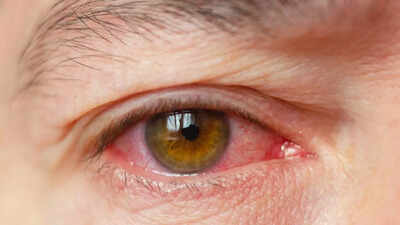ARTICLE AD BOX

Tears are a natural emotional release, but crying often leaves behind puffy, swollen eyes and traces of redness or dryness. This happens when excessive tear production overwhelms the eye’s drainage system, leading to temporary fluid retention around the delicate eye area.
While this puffiness usually fades on its own, a few simple and effective home remedies can help speed up recovery and refresh your appearance. From cooling compresses and cucumber slices to soothing tea bags and gentle massages, these easy treatments can calm irritation, restore comfort, and make your eyes look well-rested and bright again, even after an emotional moment.
8 effective home remedies to reduce puffy eyes after crying
Applying a cold compress
Cold temperatures help constrict blood vessels and reduce inflammation, which makes a cold compress one of the quickest ways to relieve puffiness.
You can use a chilled washcloth, a bag of frozen peas, or even refrigerated spoons. Gently place the compress over your closed eyes for 10 minutes to calm swelling and irritation. Ready-made gel eye masks are also an excellent option, offering consistent cooling and comfort.
According to a study published in the National Institutes of Health, Cooling (cold compress) has been shown to reduce inflammation and swelling in ophthalmic contexts.
Applying cucumber slices
Cucumber slices are a time-tested remedy for puffy eyes — and for good reason. Their high water content hydrates the skin while their cooling effect reduces swelling. Cucumbers are also rich in antioxidants and vitamin K, both of which can help minimize dark circles. Simply chill two slices of cucumber and place them over your closed eyes for 10–15 minutes for an instant soothing effect.
Using tea bags
Tea bags — particularly those containing caffeine — can help depuff the eyes thanks to their tannins and antioxidants.
Caffeine constricts blood vessels, while tannins tighten skin and improve circulation. Green tea, black tea, and chamomile tea bags are especially beneficial, with chamomile offering added anti-inflammatory properties. After steeping the tea, chill the bags in the refrigerator and place them on your eyes for about 5–10 minutes.
Trying witch hazel
Witch hazel is a natural astringent that can help tighten skin and reduce inflammation.
To use, soak cotton pads in chilled witch hazel, squeeze out the excess liquid, and place them gently over your eyes for about 10 minutes. Do this once or twice daily for visible results. However, take care to avoid getting witch hazel directly into your eyes, as it may cause irritation.
Using an eye roller
Eye rollers are convenient tools designed to massage the under-eye area and stimulate blood flow. Most rollers feature cool metal tips that soothe and tighten the skin while reducing puffiness.
Some come with built-in serums containing caffeine or hyaluronic acid for extra hydration and firming benefits. Gently roll the device in upward and outward motions around your eyes to revive tired, swollen skin.
Applying a face or eye cream
Eye creams enriched with retinol, vitamin C, hyaluronic acid, or caffeine can work wonders for reducing puffiness and hydrating delicate skin. These ingredients encourage collagen production, improve elasticity, and constrict blood vessels.
For those preferring cleaner beauty options, organic or cruelty-free creams are widely available. Applying such creams regularly, especially before bedtime, can make the eyes appear brighter and firmer over time.
Trying a gentle massage
A light massage helps stimulate circulation and encourages lymphatic drainage, both of which can reduce puffiness naturally. Use clean fingers to softly tap or massage from the inner corners of your eyes outward in slow, circular motions.
For an added cooling effect, dip your fingers in cold water beforehand. Avoid pressing too hard, gentle pressure works best for this sensitive area.
Making dietary changes
What you eat and drink has a major impact on how your eyes look and feel. Staying well-hydrated is essential; aim for at least eight glasses of water per day and include water-rich foods such as cucumber, oranges, and lettuce in your diet. Limit salt, alcohol, and caffeinated beverages, as they cause dehydration and fluid retention, both of which worsen under-eye puffiness.
Herbal teas like chamomile or green tea can also support skin health when consumed regularly.
How to manage eye redness
Redness after crying occurs because tiny blood vessels in the skin around the eyes dilate due to emotional stress or irritation. The same cold compresses and cucumber slices used for puffiness can help calm this redness. Specialized colour-reducing eye drops can also constrict blood vessels and restore brightness. Additionally, applying soothing eye creams or serums containing aloe vera or vitamin E can further reduce discoloration and refresh the delicate under-eye area.
How to manage eye dryness
Tears are made up of water, oils, and mucus, all of which nourish and protect the eyes. However, prolonged crying or environmental factors can disrupt this balance, leading to dryness or discomfort. To restore moisture, use preservative-free artificial tears or lubricating eye drops. Make sure to blink often, especially when working on a computer, and follow the 20-20-20 rule: every 20 minutes, look at something 20 feet away for 20 seconds.
When outdoors, wear sunglasses to protect your eyes from sunlight and drying winds.Puffy eyes after crying are completely normal and usually temporary. With simple home remedies such as cold compresses, cucumber slices, tea bags, and gentle massages, you can quickly reduce swelling and soothe irritation. Staying hydrated, eating healthily, and maintaining a consistent skincare routine also play a key role in preventing puffiness. If swelling, redness, or dryness persists for more than a few days, consult a doctor or dermatologist for professional advice.
With consistent care, your eyes can return to feeling calm, clear, and refreshed in no time.Disclaimer: This article is for general informational purposes only and is not a substitute for professional medical advice, diagnosis, or treatment. Always seek the guidance of a qualified healthcare provider regarding any medical condition or lifestyle change.Also Read: Home remedies for dry skin in winter: Natural ways to stay hydrated

 13 hours ago
4
13 hours ago
4









 English (US) ·
English (US) ·